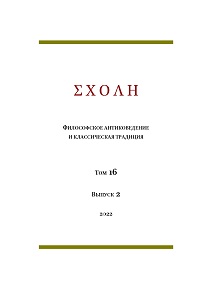От папируса из дервени до “орфических” золотых табличек
Orphica I: from the Derveni Papyrus to the “Orphic” Gold Tablets
Author(s): Eugene AfonasinSubject(s): Ancient World, Theology and Religion, Ancient Philosphy, History of Religion
Published by: Новосибирский государственный университет
Keywords: Ancient mystery cults; Early Greek philosophy; the history of religion; cosmology; ritual; eschatology;
Summary/Abstract: The paper is concentrated on the Derveni papyrus. According to the cosmology of the papyrus Zeus recreated the world anew. The meaning of this self-contained process may indicate the poet's desire to reflect the cyclicity of time, manifested in the alternation of the one and the many. Besides, this model may be related to the famous Orphic idea of the cyclic life of the soul. It is also possible that we are facing the first example of the cosmological scheme, which we later find in Heraclides of Pontus, and I think that it is no accident that the doxographer (or Heraclides himself) attributes it to the Orphics, who “make each of the heavenly bodies into a cosmos” (Aetius 2.13.15). The eternally existent universe evolves thanks to the creative energy of sky (Uranus), which is concentrated in the sun. Zeus recreates this universe on earth, building a small cosmos in which we inhabit and all that we see. Developing this idea in the spirit of Giordano Bruno, we can assume that this or that deity, in the Orphic (and Pythagorean) view, recreates from the original material a unique cosmos on each of the celestial bodies, and the universe is populated by a variety of beings inhabiting all kinds of worlds.
Journal: ΣΧΟΛΗ. Философское антиковедение и классическая традиция
- Issue Year: XVII/2023
- Issue No: 1
- Page Range: 87-119
- Page Count: 33
- Language: Russian

